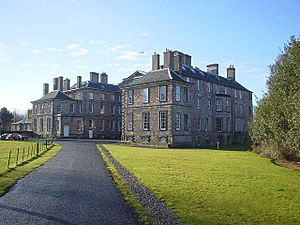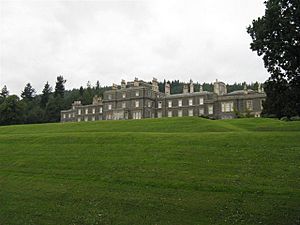Francis Scott, 2nd Duke of Buccleuch facts for kids
Francis Scott, 2nd Duke of Buccleuch (born January 11, 1695 – died April 22, 1751) was an important Scottish nobleman. He held several noble titles and was involved in learning and politics during his lifetime.
Contents
Understanding Francis Scott's Family History
Francis Scott was the son of Sir James Scott, Earl of Dalkeith. His grandmother was Anne Scott, 1st Duchess of Buccleuch. This made King Charles II of England his great-grandfather. Francis was born in London and was baptized on January 20, 1695.
When his father passed away in 1705, Francis became known as the Earl of Dalkeith. He inherited the title of Duke of Buccleuch in 1732. This happened after his grandmother, the 1st Duchess, passed away. He also gained other Scottish titles at this time.
Restoring Family Titles
Francis Scott's grandfather, the Duke of Monmouth, had lost his noble titles. This happened after a rebellion against King James II and VII. However, in 1743, some of these titles were given back to Francis. The British Parliament passed a law making him the 2nd Earl of Doncaster. He also became the 2nd Baron Scott of Tindall. These were English noble titles.
Francis Scott's Career and Public Life
Francis Scott attended Eton College when he was young. As an adult, he was very interested in learning and education. He joined groups that promoted knowledge and science.
Involvement with Learned Societies
Francis Scott was a Freemason. This was a group that often discussed scientific ideas. He served as the Grand Master of Freemasons from 1723 to 1724. In 1724, he became a Fellow of the Royal Society (FRS). This is a very old and respected group for scientists.
He was also closely connected to the Spalding Gentlemen's Society. This group studied old objects and history. Francis Scott was their first Patron, starting in 1734. In 1745, he received an honorary degree from the University of Oxford. This showed his strong support for education.
Role in Parliament
In 1725, Francis Scott was made a Knight of the Thistle. This is a special honor in Scotland. In 1734, he became a Scottish representative peer in the House of Lords. This meant he represented Scotland in the British Parliament.
However, he sometimes disagreed with the government. In 1740 and 1741, he signed protests against the government's actions. One protest asked for the removal of a powerful leader named Sir Robert Walpole. Because of this, he lost support from the government. He was not re-elected to the House of Lords in 1741. But he returned to Parliament in 1743 when he became the Earl of Doncaster.
Francis Scott's Personal Life and Estates
Francis Scott married Lady Jane Douglas in 1720. They had two sons and three daughters. Lady Jane passed away in 1729. She was buried at Dalkeith Castle.
Later, in 1744, he married Alice Powell. Both of his sons passed away before him. So, his grandson, Henry Scott, 3rd Duke of Buccleuch, inherited his titles.
His Estates
Francis Scott owned several large estates. Some were in Scotland and some in England. In Scotland, he owned Dalkeith Palace and Bowhill House. He bought Bowhill House for his son Charles in 1747. In England, his estates included Spalding in Lincolnshire, Langley in Berkshire, and Hall Place at Hurley.
Francis Scott passed away on April 22, 1751. He was buried on April 26, 1751, at Eton College Chapel.




